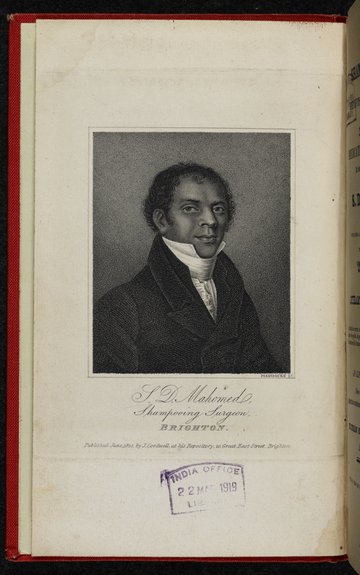
Sake Dean Mahomed
‐
Entrepreneur behind the Hindoostane Coffee House, the first Indian restaurant in London, and Mahomed’s Baths in Brighton, famous for their shampooing and vapour treatments
Other names
Sake Deen Mahomed
Din Mahomed
Dean Mahomet
Dean Mahomed
Place of birth
Date of arrival to Britain
Location(s)
34 George Street
Marylebone
London
W1U 8AQ
United Kingdom Mahomed's Baths
11 Devonshire Place
First location of Mahomed's Vapour Baths
Brighton
BN2 1QA
United Kingdom
Place of death
Brighton
Date of time spent in Britain
1784–1851
About
Sake Dean Mahomed arrived in Britain accompanying Captain Baker, whose service he entered as a camp follower in 1769 aged only 11. Mahomed rose quickly through the ranks to Subedar (captain). When Baker resigned from the army, Mahomed accompanied him to Britain, arriving in Dartmouth and then following Baker to Cork, where Mahomed entered the elite circles of Irish Protestant families. In 1786, shortly after Baker’s death, he eloped with Jane Daly. In 1794 he published the hugely successful Travels of Dean Mahomet, the first book published by a South Asian in Britain, which became a sensation.
With the loss of Baker’s patronage and changing circumstances, he moved to London in 1807, setting up home in Portman Square, Marylebone, a highly fashionable area frequented by India-returned nabobs, men who had made their wealth with the East India Company. He was first employed by Basil Cochrane, who ran a vapour bath from his mansion at 12 Portman Square, a business idea Mahomed later harnessed for his own enterprise. In 1810 Mahomed set up the Hindoostane Coffee House at 34 George Street. The establishment catered for the growing clientele of nostalgic former East India Company employees and nabobs, serving Indian cuisine in an ‘oriental’ atmosphere and also hookah smoking. Mahomed was a skilled entrepreneur and knew how to tap into the lure and appeal of an exoticized fantasy of the East. The success of the Coffee House was short-lived, and he had to declare bankruptcy in 1812. The Coffee House continued trading under new ownership till 1833.
After this business failed, Dean Mahomed and his family moved to the seaside town of Brighton, where he opened his famous vapour baths and shampooing practice, tapping into the spa culture of the time. He promoted his work through his book Shampooing; or, Benefits Resulting from the Use of the Indian Medicated Vapour Bath, outlining his practice as well as featuring endorsements from patrons. He ran his business from a range of locations: from September 1814 he set up shop in 11 Devonshire Place; in 1815 he moved the business to Battery House, which overlooked the sea and was in close proximity to the oriental-styled Brighton Pavilion. As Brighton’s popularity increased, Mahomed’s Baths were featured in guidebooks, further increasing his reputation. In 1818 he styled himself as ‘shampooing surgeon’. As his business grew, he required a bigger practice, and in 1826 he moved to a bespoke building, close to the Steine and the Brighton Pavilion. Mahomed was adept at self-promotion, using his celebrity and highlighting his methods as the latest medical science. He secured the patronage of George IV and William IV, both of whom he treated and who appointed him ‘Shampooing Surgeon to their Majesties’. Owing to the success of his Brighton business, he established in 1838 a branch in London at 7 Little Ryder Street.
As Brighton’s fashionable status declined after Queen Victoria’s accession to the throne in 1838, he ran into financial difficulties; the baths closed in 1841 and his public profile started to dwindle. His wife, Jane, died in December 1850 and Dean Mahomed died in February 1851. He is buried in St Nicholas Churchyard, Brighton.
His grandson, Frederick Akbar Mahomed, followed in his father's footsteps as a medical professional.
The Travels of Dean Mahomet, a Native of Patna in Bengal, through several parts of India, while in service of the Honourable East India Company. Written by himself, in a series of letters to a friend, 2 vols (Cork: J. Connor, 1794)
Shampooing; or, Benefits Resulting from the Use of the Indian Medicated Vapour Bath, etc. (Brighton: E. H. Creasy, 1822)
Shampooing; or, Benefits Resulting from the Use of the Indian Medicated Vapour Bath, etc., 2nd edn (Brighton: Creasy & Baker, 1826)
Shampooing; or, Benefits Resulting from the Use of the Indian Medicated Vapour Bath, etc., 3rd edn (Brighton: E. H. Creasy, 1838)
Fisher, Michael, The First Indian Author in English: Dean Mahomed (1759–1851) in India, Ireland, and England (New Delhi: Oxford University Press, 1996)
Fisher, Michael, Counterflows to Colonialism: Indian Travellers and Settlers in Britain, 1600–1857 (Delhi: Permanent Black, 2004)
Innes, C. L., A History of Black and Asian Writing in Britain, 2nd edn (Cambridge: Cambridge University Press, 2008)
Visram, Rozina, Ayahs, Lascars and Princes: The Story of Indians in Britain, 1700–1947 (London: Pluto Press, 1986)
Visram, Rozina, Asians in Britain: 400 Years of History (London: Pluto Press, 2002)
For image and copyright details, please click "More Information" in the Viewer.
Image credit
Sake Dean Mahomed, Shampooing; or, benefits resulting from the use of the Indian Vapour Bath as introduced by Sake Deen Mahomed, 2nd ed. (Brighton: Creasey and Baker, 1826), Courtesy of British Library Board
Public Domain
